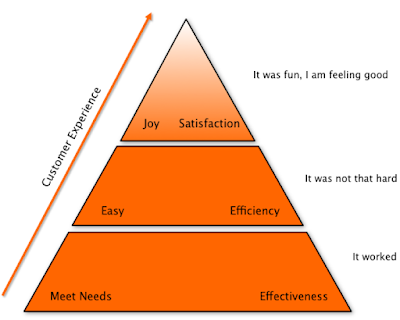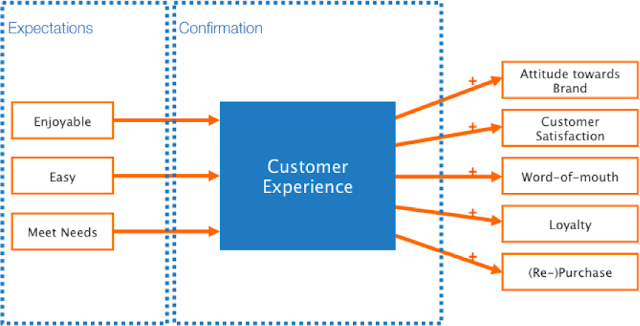Businesses are in a difficult situation.
Today’s customers demand more experiences and contextually relevant engagements
than they are equipped to deliver. This places the businesses on a difficult
and challenging trail that they need to carefully navigate in order to be and
stay successful.
The business challenge is that technology
helps everyone, especially customers. This is because to the increasing
proliferation of consumer technology, it is far easier and cheaper for
customers to implement and use technology to their advantage as it is for
businesses. A director of merchandising of a 1 Bn+ retailer put like this: “By
the time we catch up to technology it will have moved past us again.”
Examples for the truth of this statement in
the past decade include the meteoric rise of messaging services and, before
that, social media, powered by smartphones that made the Internet ubiquitous.
As a consequence of this today’s customer is less depending on company marketing-
or sales organizations and has a far higher reach when it comes to satisfying
an information need. Consequently, Google finds that a whopping 99.8 per cent
of all online ads are simply … ignored. Sales representatives are on the verge
of becoming irrelevant. An increasing number of studies find that customers
contact a sales representative only after a product decision has been made.
Other studies determine that customers are
abandoning shopping carts already following a single poor service experience.
While these studies often are commissioned by vendors there still are too many
of them to not indicate that there is a problem. After all there is bound to be
a fire where there is smoke.
Then and Now
The 1990’s customer happily believed in
corporate messaging that got delivered via unidirectional channels like TV,
radio, or the newspaper.
Today’s customer is always online,
digitally connected and socially networked. She trusts peers, ‘people like me’,
far more than corporate executives, spokespersons, or
consultants/analysts/influencers. This trend is clearly shown by the ongoing changes
in the Edelman Trust Barometer and it gave birth to notions like ‘a company
like me’ or the debatable one saying that ‘the customer is in charge’.
Today’s customers are using technology to
navigate their individual journey. This journey stretches across devices and
channels. It is non-linear and proceeds at the customer’s pace, and it doesn’t
end with the purchase.
Customers are simply following their own
preferences, not a company’s. Yet customers have precise demands to the
companies:
·
Customers want the company
being available on their communications channels of preference.
·
Customers want the company to
know more about the product or service that they are inquiring about than they
already know themselves.
·
Customers want the company to
know and address their intentions and not being bombarded with irrelevant and
out of context messaging. Information they volunteer to the company needs to be
used to their benefit.
·
At the same time customers do
not want their data being used outside the boundaries of their interests. They
do not give a perpetual license to use their information.
·
Most of all, customers want to
feel valued by the company. And one of the most valuable commodities customers
have is their time.
Pre- and post sales, companies need to
address these demands by offering a menu of interlinked contact points that
collect the right data and offer meaningful information in real time, so that
the customers can proceed on their journey with minimum friction and loss of
time. This includes the usage of the product or services – which, of course,
doesn’t necessarily give or collect data (anyone seen a can of chili collect
usage data?).
Pre- and post sales, and interaction with products,
are also why I chose the term contact points instead of the better
known touch points, as the term touch points is nowadays somewhat
delimited to marketing. Anyone having a better term please let me know…
Companies that succeed in building this menu
have established a technical foundation for engaging in a way that results in
good experiences. Of course a technical foundation is not enough. Companies
also need to cover the even more important aspects of people, process, or culture.
But: Why do experiences matter?
And how to get there?
Experiences Are Created Through Engagements
In an operationalized adaptation of a definition
given by Paul:
“Customer Engagement is the ongoing
interaction between company and customer, using contact points that are offered
by the company and chosen by the customer.”
This is where the traditional notion of CRM
falls short and where we need to turn it into Customer Engagement Management –
CEM.
CRM in a traditional sense, rightly or
wrongly, focuses on making the transaction and is mainly driven by a strategic
focus on internal needs. As a consequence there is no view on a long-term
customer relationship and therefore the value added for the customer is
comparatively low. Once can also see this in many traditional loyalty schemes
that are rather built for ring fencing customers than for making them loyal. It
is an inside-out view that emphasizes the interests of the company over those
of the customer.
What if a company took a different stance?
A position where not the transaction and the company needs are taking center
stage but customer interactions, conversations, and service and where strategic
decisions are taken around fulfilling the customer’s needs? This way the
company is able to offer a high value to the customer during a long-term
relationship. Conversely, the customer shares this added value with the company
through repeat transactions. The transaction is no more a goal but an engagement
amongst others, an engagement that leaves an experience.
In a way one can say that businesses serve
themselves best by serving their customers best.
 |
| From CRM to CEM |
But how does this tie into customer
experience, I hear you ask.
According to Wikipedia
“Customer Experience is the sum of all
experiences a customer has with a supplier of goods or services, over the
duration of their relationship.”
Of course there can be positive and
negative experiences. And there is another catch: Experiences, good and bad,
fade over time. The most recent ones supersede older ones. This is why
companies can ‘turn around’ bad experiences with good customer service. But
this observation also says that it pays off to be consistent – after all
customer service can be expensive.
On the other hand there is also no point in
striving for consistently exceeding customer expectations. For one this
ambition leads to a vicious circle; expectations rise endlessly.
The Simplified Maslov Pyramid of Customer Expectations
Similar to Maslov’s
hierarchy of needs customer expectations form a hierarchy that stretches
from basic to ones of higher order. It is simplified in the sense of having
only three layers that start from rationality and bring more and more emotions
into the picture.
And there is no point in concentrating on
the higher order expectations if the basic ones are not met before. Efficiently
selling a customer something that she doesn’t want nor need is probably not
going to be a (lasting) good experience.
 |
| The 'Maslov Pyramid' of Customer Expectations |
Customer experience is not about continuously exceeding expectations but about first consistently fulfilling the customers’ needs and then using the change created by that to create little ‘wow’ moments. First and foremost the customers need you being available their way and you reliably and accurately providing them, initially with accurate and reliable information, then with what they really want. There is nearly no chance of impressing or wowing customers at this level. Failing at this level, however, creates negative experiences and frustrations. Think “Your call is important to us – due to an exceedingly high call volume …” or different company representatives giving different answers to the same question., or a dress not being available in the right size in one store with the associate not being able or willing to look up whether it is available in another store.
First, meet the needs!
From then on make it easy and joyful for
your customers.
The secret sauce lies in finding the right
way. What is easy and joyful for the customers? The easiest way to find out is
usually asking them, even in times that are as digital as ours.
But does it pay?
Improving Customer Experience Is Good For Business
It does.
Meeting expectations provides the customer
with a confirmation, a positive reinforcement. Consistently meeting
expectations then leads to various positive results for the business, starting
from a higher customer satisfaction, the chance of repeat purchases and leading
to an improved and positive attitude towards the brand, ultimately creating a
loyal customer who does not return because of a discount but because of being
convinced of getting the best value.
 |
| Improving Customer Experience delivers Tangible Results |
This is also confirmed in a number of studies that tie a focus on customer experience to tangible, measurable business outcomes.
Focusing on a good customer experience
through delivering the outcomes that a customer desires in an efficient and –
for the customer – joyful way pays off for the business. Don’t look at yourself
but at the customer and reap the benefits.

Comments
Post a Comment